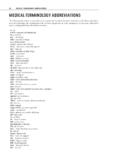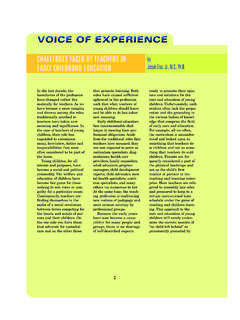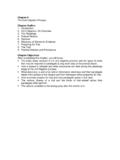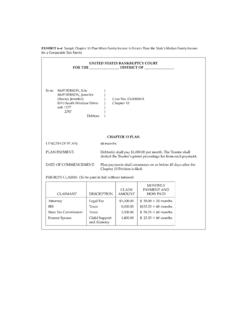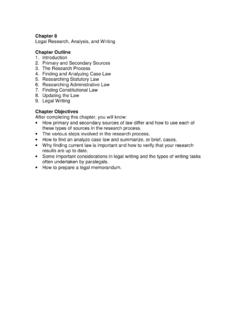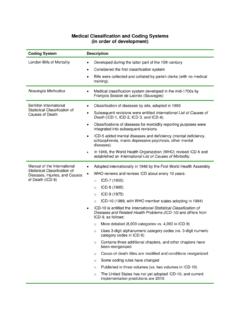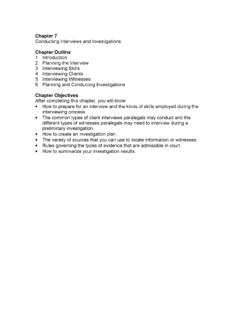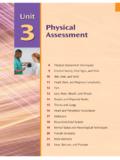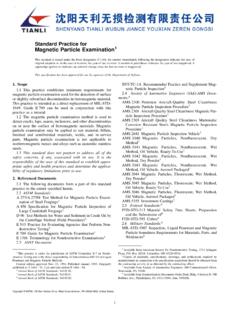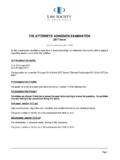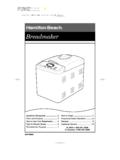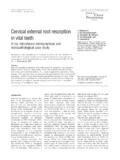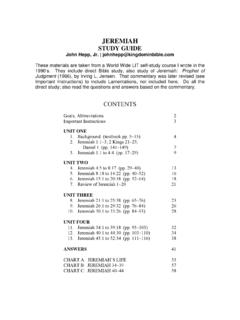Transcription of Head-to-Toe B3 Assessment - Brands Delmar
1 Head-to-ToeAssessment39 Refer to Chapter 2 Assessment , p. 65: Care Plan Developed after Using theHead-to-Toe Assessment modelClient s Name: Mr. Simon DawkinsAge: 45 Activity 1 Read the Dawkins scenario to ascertain correct identification of the 2 Examine the pathophysiological responses of the inflammatory process in orderto teach prevention and curative 3 Examine the completed Assessment for Mr. Dawkins. Note the differences inprevious Assessment formats. Review the nursing care plan for sequencing indi-vidualization and 4 Compare the Head-to-Toe Assessment with other Assessment models and developappreciation for this to tissue(First line of defense is skin)White blood cells move todestroyed areasExudateformationHealing bysecondaryintentionPhagocyte activity ofneutrophils andmonocytesCollection andpassage of whiteblood cellsReticuloendothelial systemactivityMonocytesPhagocytosisNeutr ophilsEosinophilsand basophilsFIGURE B3 1 Pathoflow sheet showing cellular response to 5 Examine the nursing care plan developed for Mr.
2 Dawkins. Determine the rela-tionship between the component parts. Identify at least two other diagnosesthat would be appropriate for this Assessment USING THE HEAD-TO-TOEAPPROACH CARE PLANS DEVELOPED ON 1 PRIORITY PROBLEMS RELATES TO MR. SIMON DAWKINSHead-to-Toe ApproachScenario:Mr. Simon Dawkins is a 45-year-old male who sustained a wound to his rightfoot after the area was crushed by a stone. The client stated the incident hap-pened a week ago and that he had been washing it with an old washcloth in abasin but instead of it healing it has gotten larger and full of pus. On exami-nation the foot was wrapped in an old dirty towel that contained blotches ofblood-stained : Client ProfileName: Mr. Simon DawkinsAge: 45 Sex: MaleMedical Diagnosis: Infected right signs:Temperature: 101 FPulse: 100 Respirations: 22 Height: 5 6 Weight: 160 lbs.
3 (ideal body weight 163 lbs.)General Appearance:Color: Pink (face flushed)Orientation: Oriented 3 (time, place, and person)Dress, Grooming: Clothing soiled and crushed shoes (boot old and cracked)right boot tied with cord on bottom of affected foot. Hair dry and : Posture slightly stooped to accommodate pain of right footAbility to stand and walk: Able to walk moves slowly because of discomfortof right and balance: Somewhat unsteady (accommodating discomfort from rightfoot)Ability to perform self-care (activities of daily living): Able to perform activi-ties of daily living but seems to lack knowledge about hygiene and the infec-tious , Hair, and NailsHair quality and distribution: Hair is poorly maintained and dry (on scalp)hair black on eyebrows, eyelashes, and body neither balding alopecia norpediculosis observed, even turgor: Skin uniformly pink (somewhat flushed), no bleeding, increasedvascularity, no ecchymosis except on right foot.
4 Right foot, skin red ecchymo-sis with some pink drainage with some lesions: No lesions except on right foot (large infected lesion).Palpation of skin: Moisture, dry; skin surface quite warm including hands andfeet temperature 101 : Skin feels smooth, even, and firm except for hair growth on chest andon right foot (ecchymosis).Turgor: Normal (skin returns to original contour rapidly when released).Edema: No edema present except of right : Normal, pink cast, capillary refill, color returns to normal within 2 and configuration: Nail surface smooth and flat. Thickness uniformexcept for slight splintering of the : Nail base firm on , Face, and NeckOrientation: Client oriented to time, place, and : Long- and short-term memory : Responds to questions and commands easily.
5 Speech is clear andunderstandable. Pitch, rate, and volume :Auditory screeningVoice whisper test normal (able to repeat words whispered from a distanceof 2 feet).Tuning fork tests Weber and Rinne Weber Test Normal (perceives soundequally in both ears).External EarInspection normal (matches flesh color of rest of skin [flushed]).42 Appendix B3 Positioned appropriately (positioned centrally and in proportion to the head).Palpation: Normal (no complaints of pain or tenderness on palpation).Otoscopic Assessment : Normal ear canal no redness, swelling, tenderness,lesions, drainage, foreign bodies, or scaly surface areas; cerumen small membrane pearly gray, light reflex at 5 o clock in right ear and 7 o clock in left. Blood vessels visible only on periphery. No bulging or retrac-tion of the membrane, no evidence of fluid collection.
6 Tympanic membranemoves when client blows against acuity: normal 20/20 Near vision: normal able to read at a distance of 14 vision: Normal able to identify primary colors found in the fields: Normal able to see the stimulus at about 90 degrees temporal,60 degrees nasally, 50 degrees superiority, and 70 degrees : Symmetrical, no drooping, infections, or tumors of the lids. Eyebrowspresent bilaterally, symmetrical without lesions or ApparatusInspection: No enlargement, swelling, or redness, small amount of exudate,minimal : No excessive tearing or discharge from the Muscle FunctionCorneal light reflex (Hirschberg Test): Normal light reflex seen symmetricalin the center of each test: Eyes in fields of gaze (extraocular muscle movement): normal both eyesmove symmetrically and smoothly in each of the six fields of cage.
7 Convergeon head object as it moves toward the Segment StructuresConjunctiva in bulbar: Normal transparent with small blood vessels, noswelling, injection, exudates, foreign bodies, or : Normal while with small superficial vessels, no exudates, lesions orforeign : Normal surface moist and shiny, no discharge, cloudiness, opacitiesor Chamber: Normal even distribution of light in anterior : normal color evenly distributed over : normal deep black, round, equal in diameter (approximately 4 mm.)constrict briskly to direct and sensual light and to : normal transparent in Segment StructuresRetinal structures: Normal red reflex present, optic disc pinkish in color withyellow-white excavated center. Four main vascular branches emanate fromdisc. Venules larger than arterioles and are darker in color no signs of edemaor : Normal dark with pinpoint reflective and TeethMouth: Smells foul (halitosis probably due to poor oral hygiene).
8 Tongue: In midline of mouth, dorsum pink, moist, ventral portion with promi-nent blood vessels, no lesions : Lips and membranes pink and moist, no evidence of lesions : No flaccidity, no lesions s ducts: Patent, no inflammation or lesions. Lateral aspect pink,smooth, without mucosa: Pink, moist, smooth, and without : Thirty-two teeth in place, several caries : Hard and soft palate concave and pink, no lesions or of throat: Soft palate and uvula rises symmetrically when clientsays Ah, uvula midline, throat pink and vascular without swelling, exudatesor lesions. Gag reflex present, tonsils XI (visible).Cranial NervesI. Normal findings (able to distinguish various odors).II. Visual acuity 20/30 OU, funduscopic examination Eyes deviate in direction opposite the Both eyes move smoothly and symmetrically in each of the six fields ofgaze and converge on held object as it moves toward the B3V.
9 Masseter and temporalis muscles equally strong on palpation sensation tolight touch and pain, intact EOM normal findings (both eyes move symmetrically in each of the six fields of gaze, converge on held object toward the nose, no nystagmus;pupils equal, round briskly, react to light and accommodation PERRLA). Motor component face symmetrical. Sensory component (identifiessweet, sour, salty, and bitter tastes accurately).VIII. Gross hearing intact: Rinne AC BC, Weber O , X. Gag reflex present, speech clear, no hoarseness or nasal quality, swal-lows water Turns head against resistance with smooth, strong, and symmetrical Tongue in midline of the mouth symmetrical and moves FunctionCoordinationFinger to nose, no impairment on either from nose to examiner s finger coordinated to shin deferred (fractured femur).
10 StationPosture not tested, unable to not tested, unable to walk (fractured femur).Romberg, unable to test deep tendon reflexesBrachioradialis 2 bilaterally, biceps 2 bilaterally, triceps 2 bilaterally,patella 3 bilaterally, planter 2 bilaterally, Achilles 2 bilaterally,Babinski (shape of thorax): Ratio of anterior posterior diameter to the trans-verse diameter is 1 2 (wider from side to side than from front to back). Thoraxslightly elliptical in of Chest Wall: Shoulders and scapula at same height bilaterally, nomasses angle: Less than 90 degrees during exhalation at rest, widens slightlyduring inhalation (normal).Angle of the ribs: Ribs articulate at 45 degrees with sternum (normal).AppendixB345 Intercostal spaces: No retractions or of respiration: Using no accessory : Respirations 18 per minute eupnea (normal breathing).

